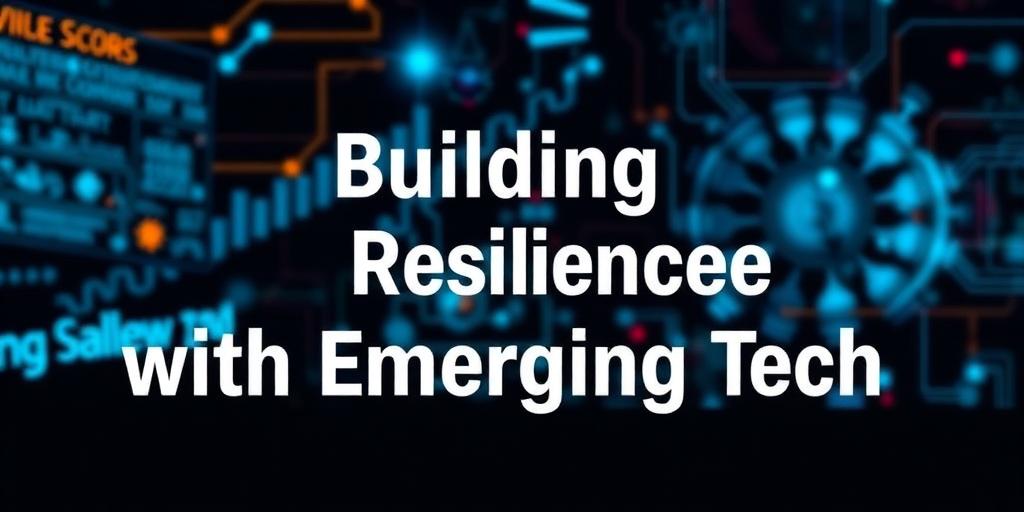Building Resilience with Emerging Tech
In an era defined by rapid technological advancement and unforeseen global challenges, building resilience is more critical than ever. Emerging technologies offer powerful tools to help individuals, organizations, and communities adapt, recover, and thrive in the face of adversity. This post explores how emerging tech can foster resilience across various sectors.
Understanding Resilience
Resilience is the ability to bounce back from difficulties. It's about adapting well in the face of trauma, tragedy, threats, or significant sources of stress. In a world increasingly impacted by climate change, economic instability, and social disruptions, resilience is not just a desirable trait but a necessity.
Key Emerging Technologies for Building Resilience
Several emerging technologies are playing a pivotal role in enhancing resilience:
- Artificial Intelligence (AI) and Machine Learning (ML): AI and ML algorithms can analyze vast amounts of data to predict potential disruptions, optimize resource allocation, and automate responses to crises. For example, AI-powered systems can forecast weather patterns, detect cyber threats, and manage supply chain disruptions.
- Internet of Things (IoT): IoT devices provide real-time data on infrastructure, environmental conditions, and public health. This data can be used to monitor critical systems, detect anomalies, and trigger timely interventions. Smart sensors in buildings can detect structural weaknesses, while wearable devices can monitor health indicators during a pandemic.
- Blockchain: Blockchain technology offers secure and transparent platforms for managing supply chains, verifying identities, and distributing aid. Its decentralized nature makes it resistant to single points of failure, ensuring continuity in critical operations.
- Cloud Computing: Cloud services enable organizations to store and access data and applications from anywhere, ensuring business continuity during disasters. Cloud-based platforms also facilitate collaboration and communication, enabling rapid response and recovery efforts.
- Drones and Robotics: Drones can access remote or hazardous areas to assess damage, deliver supplies, and provide situational awareness. Robots can automate dangerous tasks, such as search and rescue operations, reducing risks to human responders.
Applications Across Sectors
- Healthcare:
- AI-driven diagnostic tools can quickly identify and respond to disease outbreaks.
- Telemedicine platforms can provide remote healthcare services, ensuring access to care during emergencies.
- IoT devices can monitor patients' health in real-time, enabling proactive interventions.
- Supply Chain Management:
- Blockchain technology can enhance supply chain transparency and traceability, reducing disruptions and ensuring the authenticity of products.
- AI-powered analytics can predict supply chain bottlenecks and optimize logistics.
- IoT sensors can monitor the condition of goods in transit, preventing spoilage and damage.
- Infrastructure:
- IoT sensors can monitor the structural integrity of bridges, buildings, and other critical infrastructure.
- AI algorithms can analyze data to predict potential failures and optimize maintenance schedules.
- Drones can conduct inspections of remote or hazardous infrastructure, reducing the need for human workers.
- Emergency Response:
- AI-powered platforms can analyze real-time data to coordinate emergency response efforts.
- Drones can provide aerial views of disaster areas, helping responders assess damage and locate survivors.
- Robots can assist in search and rescue operations, particularly in hazardous environments.
Challenges and Considerations
While emerging technologies offer immense potential for building resilience, several challenges and considerations must be addressed:
- Data Security and Privacy: Protecting sensitive data from cyber threats is crucial. Robust security measures and privacy protocols must be implemented.
- Digital Divide: Ensuring equitable access to technology is essential. Efforts should be made to bridge the digital divide and provide training and support to underserved communities.
- Ethical Considerations: Addressing ethical concerns related to AI bias, data usage, and job displacement is vital.
- Integration and Interoperability: Ensuring that different technologies can work together seamlessly is necessary for effective resilience.
Conclusion
Emerging technologies are revolutionizing the way we approach resilience. By leveraging AI, IoT, blockchain, cloud computing, and drones, we can build more resilient systems, organizations, and communities. As technology continues to evolve, it is crucial to address the challenges and considerations associated with its adoption to ensure that it benefits all of society. Embracing these technologies and integrating them into resilience strategies will be essential for navigating the complexities and uncertainties of the future.









